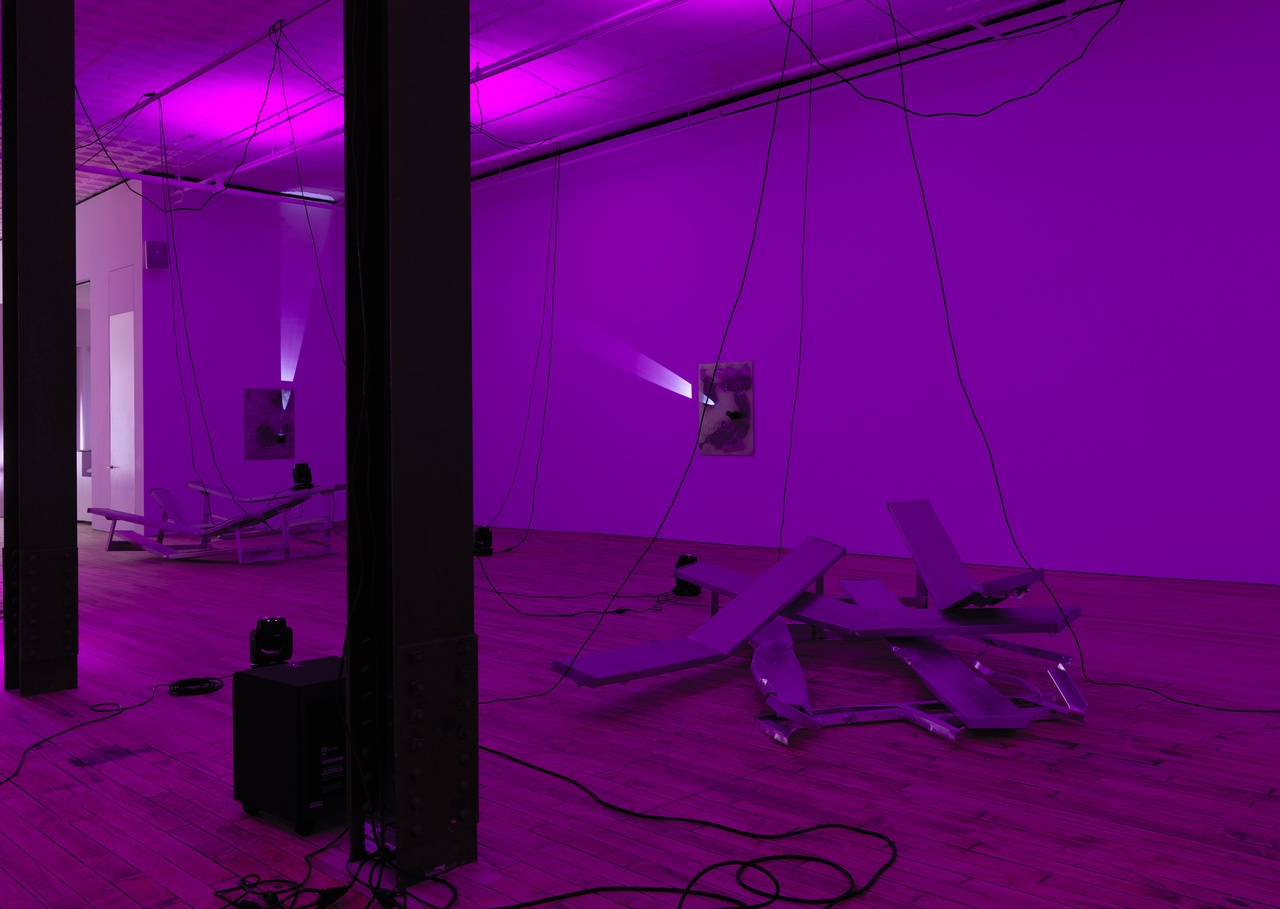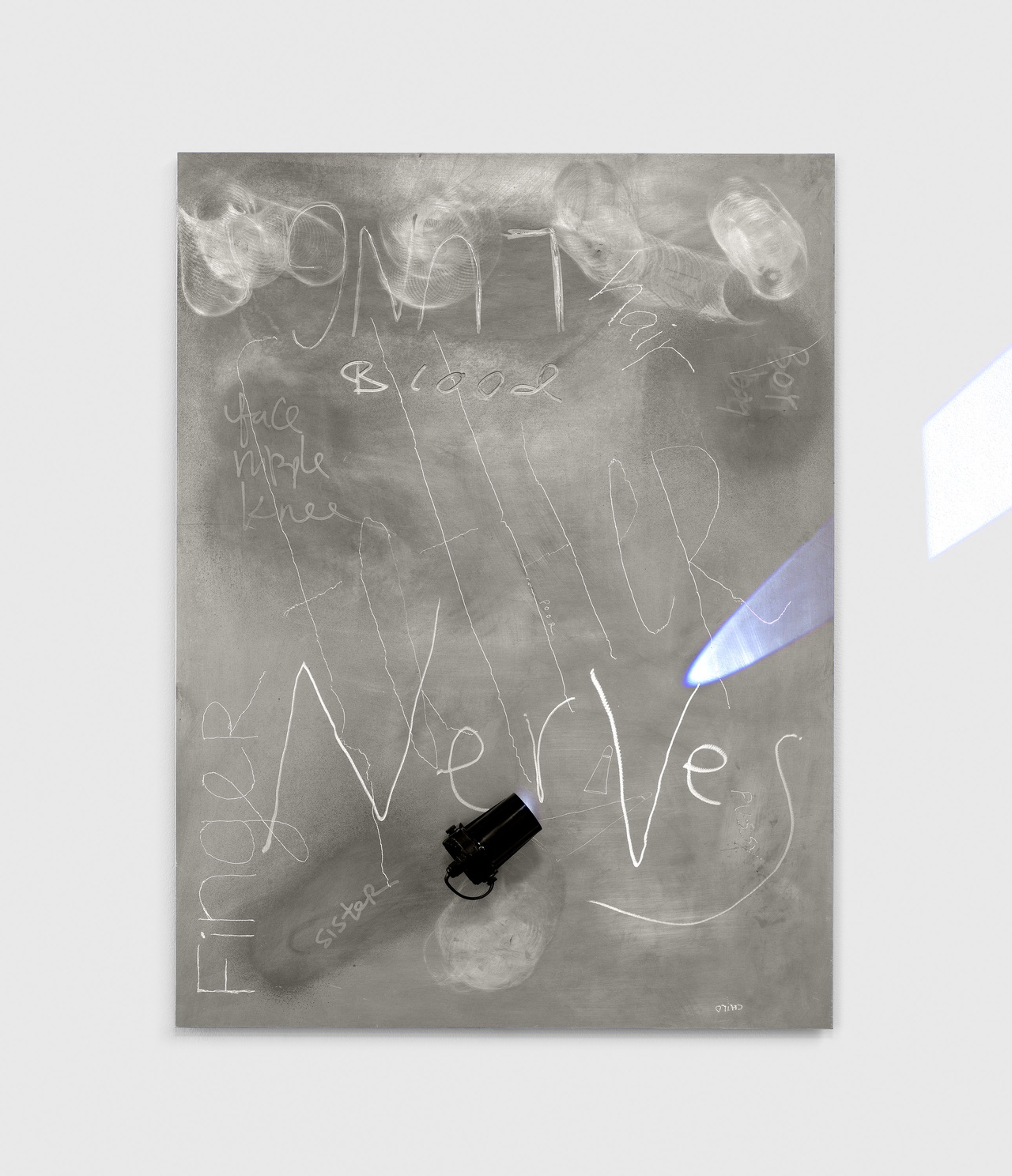NOT A SPECTACLE: NAVIGATING THE BROKEN ARENA Annika Haas on Nikita Gale at 52 Walker, New York

“Nikita Gale: END OF SUBJECT,” 52 Walker, New York, 2022, installation view
In 2020, Nikita Gale contributed a text to this magazine’s Notes from Quarantine column, reflecting on the ongoing fatal police violence against Black bodies and how digital media and the pandemic decentralized the witnessing of these murders, writing “the project of the United States of America has always been a slow ruin, not a spectacle.” [1] I read Gale’s recent show “END OF SUBJECT” at 52 Walker – the newly opened branch of David Zwirner, programmed and led by director Ebony L. Haynes – as a continued investigation into the conditions and different possibilities of witnessing. The locus and starting point of that investigation is the human body, or, more precisely, each body that enters the gallery space and begins to move between the installation END OF SUBJECT, comprised of six bleachers and an automated light-and-sound system, and the BODY PRINT series of six rectangular aluminum panels that surround it.
Through its title, the latter work relates to David Hammons’s Body Prints (1968–79). Hammons used, among other materials, margarine, pigments, and the “body as a drawing tool.” [2] But Gale’s “prints” are inscriptions rather than impressions of bodies. The title of each BODY PRINT is cut out of the metal and refers to the physical materiality of bodies: “BLOOD,” “BREATH,” “MUSCLE,” “BRAIN,” “BONES,” “PISS.” The panels also hold small LED spotlights and handmade etchings of body-related vocabulary. These “scratchitis” [3] remind me of public but intimate places like restrooms or waiting areas, including their smells and sticky surfaces. Despite these associations, Gale’s “prints” appear almost sterile. The cold light that the tiny spotlights cast over the metallic surfaces adds to this impression. Yet, on the level of text, the etched mappings of a body and its relations seem to be very personal. Reading them feels almost intrusive, since it is my gaze that makes the connections as it wanders along the words. For example, in BODY PRINT: BLOOD, the light accentuates the letter v in the word “nerves,” which touches a vertically written “finger.” “Sister” floats below “nerves,” which also intersects with a thinly etched “father” in the background. My hesitance to interpret why some of the words in these “prints” touch each other, and why some of them don’t, made me aware of the role of the viewer in this show with its rather loosely related elements: to engage with the ways that we navigate, connect to, and read these elements as well as spaces and, not least, artworks. And to become aware of the structures in which our readings are situated.

Nikita Gale, “BODY PRINT: BREATH,” 2022
Rather than offering some didactic perspective on these structures, the installation END OF SUBJECT deconstructs what Jenny Odell has called our surrounding “attention-holding architecture.” [4] Gale’s work has previously been concerned with these architectures. Like the installation PRIVATE DANCER (2020) and the kind of anti-stage for Gale’s performance AUDIENCING (2020), END OF SUBJECT consists of technical equipment and other elements that are used in sports, music, and political arenas. But in all of these artworks, the spatial, acoustic, and visual patterns that usually direct an audience’s attention toward a central stage are not only subverted but broken. In END OF SUBJECT this translates into an erratic installation landscape that extends over most of the vast gallery space and left me struggling to find an immediate entry point. The installation is an assemblage of loudspeakers, a subwoofer, cables, six aluminum bleachers, and spotlights. The lights point in different directions; they are installed on the ceiling and on the floor and some sit on the bleachers. Three of these bleachers are heavily bent, and one is turned over. Despite the impression of destruction, the aesthetics of this arrangement convey a sense of perfection. This becomes strongly apparent through the impeccable surfaces of the dysfunctional bleachers and through the partly knotted cords that hang loosely from the high ceiling, resembling a drawing in the air.
On the acoustic and dramaturgical level of the installation, Gale pushes convenient performative patterns to their limits without fully abandoning them. This occurred to me in particular when engaging with the unpredictable rhythm of the composition that animates the installation END OF SUBJECT. The sounds turn on and off together with the lights, structuring the installation into active and dormant phases, which vary greatly in length. In the “active” state, the lights move, change colors, freeze, or shut down in sync with ambient music, recorded voices or sounds of coughing that travel fast through the installation’s four-channel sound system. What appears to be randomized sequences is in fact a series of twelve so-called vignettes unfolding over the course of a two-hour-and-fifteen-minute loop that Gale created in collaboration with the composer Tashi Wada and the lighting designer Josephine Wang. The composition leaves the audience in the dark not only about when and for how long but also about where the next vignette will occur. In each phase, different sections of the expansive installation are animated and illuminated. Since the vignettes cannot all be observed fully from one point, the audience has to move through the space over the course of the composition. This movement is also prompted by the speakers’ relatively quiet volume – which sometimes blends with the bustle of Walker Street – relative to the huge space. This blurring of the clear distinctions between gallery space and artwork continues on the visual level: the daylight from the huge gallery windows merges with the LED light.
This all contributes to an impression that Gale refrains from immersing visitors in a sharply defined installation, and thus from providing a “structured” experience of the work. The artist withdraws from an aesthetics that makes a show easily consumable. This is not only the strength of “END OF SUBJECT,” it is also the exhibition’s proposition: to forget the supposed opposition between visitor (subject) and artwork (object), as well as the expectation that the visitor is going to be presented with a universally identifiable topic or message. Instead of providing the latter, “END OF SUBJECT” exposes each visitor to their own subjective approach to the show. In my case, the inconvenience of changing my location according to the installation’s erratic rhythm disrupted my habit of reading any kind of text I can find in a gallery and immediately making notes. While END OF SUBJECT ushered me through the space, I adapted a way of “embodied” reading instead – focusing less on the semantic and more on the aesthetic connections between the different elements of the installation. However, shifting back to analysis, I came across the aforementioned “structures” of reading. When I tried to make sense of the bleachers, I had no particular connection to that seating furniture and its most popular context, North American sporting venues. This reminded me that an artwork is also always conditional on the experience and the situatedness of each body.

Nikita Gale, “END OF SUBJECT" (detail), 2022
In my case, this brought up the association that the overturned bleacher looked like a barricade. It took me back to Paris in 2020, where I had been a bystander to burning, overthrown trash cans and their acrid smell at one of the protests during the general strike. Now, in Tribeca with this in mind, the overturned bleacher was a barricade. But I knew too little to determine if it referred to any particular protest. Looking more closely at the bleachers didn’t help to figure that out. Instead of providing information, their shiny surfaces did nothing but reflect my projections, which were about to overwrite the discomfort I felt because of my lack of knowledge about the specificity of these cultural references.
Returning to Gale’s quarantine note “Slow Ruin,” I was confronted with the fine line between situated and projective ways of reading artworks. In the note, the artist asks, “What events take the stage? What is spectacular enough to leverage sentiment, the most valuable of which seems to always be outrage?” What events took the stage in my mind when seeing this show? Why did I read the bleachers as a sign of public outrage and violence? Despite the aesthetic refusal of “END OF SUBJECT” to present me with a spectacle, the spectacle nevertheless produced itself in my mind. In “Slow Ruin,” Gale highlights the ethical and political implications of these dynamics. Against the background of witnessing Philando Castile’s death in 2016 through a widely circulated video, the artist asks to what extent this death and further “local horrors and violence are legitimized by the global audience.” With this question, Gale points to the ambivalent character of witnessing, which always has the potential to turn any horror into spectacle. I read “END OF SUBJECT” as a continued criticism of an attention economy in which spectacle ranks the highest. At the same time, the show attempts to articulate forms that do not buy into these aggressive economies. It asks how we can witness, assemble, mourn, and acknowledge injustice and violence differently. Gale’s “broken” arenas are a good starting point to activate the “slow ruin” that underlies these pressing questions and to reconsider them on an intellectual and embodied level.
“Nikita Gale: END OF SUBJECT,” 52 Walker, New York, January 21–March 26, 2022.
Annika Haas is a media theorist and works as a research associate at Berlin University of the Arts (UdK).
Image Credit: © Nikita Gale. Courtesy the artist and 52 Walker, New York.
Notes
| [1] | Nikita Gale, “Slow Ruin,” Notes from Quarantine, Texte zur Kunst, August 26, 2020. |
| [2] | See the exhibition webpage “David Hammons: Body Prints, 1968–1979,” Drawing Center, Feb 5–May 23 2021. |
| [3] | Adam Kleinman, “Nikita Gale’s End of Subject,” Art Agenda, February 11, 2022. |
| [4] | See Jenny Odell, How to Do Nothing: Resisting The Attention Economy (New York: Melville House, 2019). Odell’s book is on the list of “related readings” that were crucial in the making of the show and that can be found on the gallery’s website, which serves as an index and knowledge repository for each show the gallery puts on. The books are also part of 52 Walker’s circulating library. |
